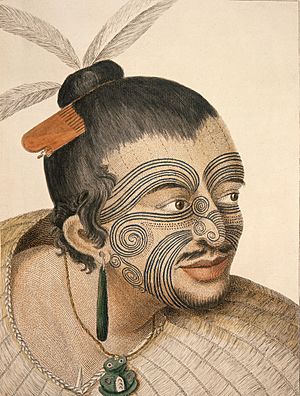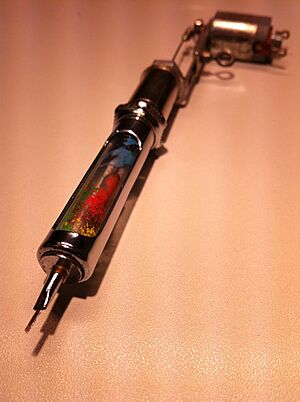Tattoo facts for kids
A tattoo is a lasting mark made by putting ink into your skin. People get tattoos on their bodies as a way of changing how they look. Animals sometimes get tattoos too, usually to help identify them. Tattoos can also show that someone belongs to a certain group or culture.
People usually get tattoos at places called tattoo parlors. Getting a tattoo can be painful, but how much it hurts depends on the person and where on the body the tattoo is placed. Most tattoos today are made with an electric tattoo machine. This machine uses small needles to put ink into the skin.
Contents
The History of Tattoos
Tattooing is a very old art form. One of the oldest examples is Ötzi the Iceman, a man who lived about 5,300 years ago. His mummy was found in 1991. Ötzi had 61 tattoos made of soot on different parts of his body. These tattoos might have been an early form of acupuncture, a type of traditional medicine. Tattoos have also been found on mummies from ancient civilizations around the world, like Egypt and South America.
Tattoos became popular in the Western world after Europeans met American Indians and Polynesians in the 1700s. James Cook, a famous British explorer, saw tattooing in Tahiti in 1769. The word "tattoo" actually comes from the Tahitian word "tatau."
Tattoos in Different Cultures
In some cultures, tattoos have special meanings. For example, Polynesian people, like the Māori in New Zealand, have a tradition of face tattoos called moko. These tattoos are very important and show a person's status and family history.
In other cultures, tattoos are not allowed. For example, tattoos are forbidden in Jewish law. The Bible, in the book of Leviticus, says: "You shall not make any cuts on your body for the dead or tattoo yourselves."
Tattoos started to become popular in the United States and England in the 1860s and 1870s. At first, soldiers and sailors often got tattoos. Martin Hildebrandt, a German immigrant, was the first known professional tattoo artist in the U.S. He tattooed soldiers during the American Civil War. By the 1870s, tattoos became fashionable among some wealthy people and even royalty.
Since the 1970s, tattoos have become a common part of fashion in Western countries. Many people, both men and women, from different backgrounds and ages, now have tattoos. For many young people, tattoos are a way to express themselves. In the past, tattoos were sometimes seen as breaking social rules. Today, they are often seen as an acceptable form of expression.
At different times in history, people were forced to get tattoos to mark them. For example, the ancient Romans tattooed criminals and enslaved people. In the 19th century, some prisoners and soldiers who left the army without permission were marked with tattoos. In the 20th century, prisoners in Nazi concentration camps were tattooed with identification numbers.
Types of Tattoos
Amateur and Professional Tattoos
Today, people choose to get tattoos for many reasons. Tattoos can show that a person belongs to a certain group. For example, some tattoos might show a person is part of a specific group. Tattoos, including full-body tattoos, are popular among the Yakuza, a group in Japan.
Cosmetic Tattoos
Tattoos can also be used for cosmetic (beauty) reasons. Cosmetic tattoos include "permanent makeup." This uses tattooing to create designs that look like real makeup. For example, cosmetic tattoo artists can create tattooed eyebrows for people who have lost their eyebrows due to old age, diseases like alopecia (hair loss), or certain medications. Cosmetic tattoos can also cover up moles or hide skin that has changed color due to conditions like vitiligo.
Cosmetic tattoos can also cover up surgical scars, such as those from a mastectomy (breast removal surgery). Using artistic tattoos to cover mastectomy scars is becoming more common.
Medical Tattoos
Tattoos can also be used for medical reasons. For example, a person might get a medical alert tattoo. This tattoo warns others that they have a certain medical condition, like diabetes or a severe allergy. When people receive radiation therapy for cancer, small tattoos may be used. These tattoos mark the exact spot where the radiation beam should be aimed. This helps make sure the person gets the correct treatment in the right place every time.
Health Risks of Tattoos
Because tattooing breaks the skin, it has some health risks. These risks include infection and allergic reactions to the tattoo inks. These problems can often be avoided if the tattoo artist follows strict rules for cleanliness. They should use certain tools only on one person and sterilize their equipment after every use. This special cleaning kills germs.
In many places, tattoo artists must be trained on how to prevent the spread of blood-borne diseases. These are diseases that can spread through blood, like HIV and hepatitis. As of 2009 in the United States, there were no reported cases of someone getting HIV from a professional tattoo.
However, with amateur tattooing, like tattooing done in prisons, there is a much higher risk of infection. Unclean tattoo equipment or contaminated ink can spread infections on the skin. It can also spread fungal infections, some forms of hepatitis, herpes simplex virus, HIV, staph, tetanus, and tuberculosis.
Most people are not allergic to tattoo inks. But there have been cases of allergic reactions, especially to certain colors. Sometimes this happens because the ink contains nickel, which can cause a common metal allergy. If tattooing pierces a blood vessel, a bruise might appear.
Removing Tattoos
Some people who have tattoos later wish they did not have them. Tattoos can be removed with laser surgery. However, this process can be painful and often requires several visits to a dermatologist or skin care professional.
Related pages
- Scarification
- Flash (tattoo) - a sheet of paper or card with tattoo designs printed or drawn on
See also
 In Spanish: Tatuaje para niños
In Spanish: Tatuaje para niños



